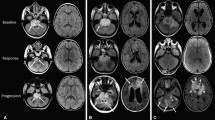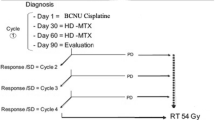Abstract
Recurrent diffuse intrinsic pontine gliomas (DIPG) are traditionally treated with palliative care since no effective treatments have been described for these tumors. Recently, clinical studies have been emerging, and individualized treatment is attempted more frequently. However, an informative way to compare the treatment outcomes has not been established, and historical control data are missing for recurrent disease. We conducted a retrospective chart review of patients with recurrent DIPG treated between 1998 and 2010. Response progression-free survival and possible influencing factors were evaluated. Thirty-one patients were identified who were treated in 61 treatment attempts using 26 treatment elements in 31 different regimens. The most frequently used drugs were etoposide (14), bevacizumab (13), irinotecan (13), nimotuzumab (13), and valproic acid (13). Seven patients had repeat radiation therapy to the primary tumor. Response was recorded after 58 treatment attempts and was comprised of 0 treatment attempts with complete responses, 7 with partial responses, 20 with stable diseases, and 31 with progressive diseases The median progression-free survival after treatment start was 0.16 years (2 months) and was found to be correlated to the prior time to progression but not to the number of previous treatment attempts. Repeat radiation resulted in the highest response rates (4/7), and the longest progression-free survival. These data provide a basis to plan future clinical trials for recurrent DIPG. Repeat radiation therapy should be tested in a prospective clinical study.


Similar content being viewed by others
References
Rubin G, Michowitz S, Horev G et al (1998) Pediatric brain stem gliomas: an update. Childs Nerv Syst 14:167–173
Broniscer A, Gajjar A, Bhargava R et al (1997) Brain stem involvement in children with neurofibromatosis type 1: role of magnetic resonance imaging and spectroscopy in the distinction from diffuse pontine glioma. Neurosurgery 40:331–337, discussion 37–38
Broniscer A, Laningham FH, Sanders RP, Kun LE, Ellison DW, Gajjar A (2008) Young age may predict a better outcome for children with diffuse pontine glioma. Cancer 113:566–572
Mauffrey C (2006) Paediatric brainstem gliomas: prognostic factors and management. J Clin Neurosci 13:431–437
Hargrave D, Chuang N, Bouffet E (2008) Conventional MRI cannot predict survival in childhood diffuse intrinsic pontine glioma. J Neurooncol 86:313–319
Giussani C, Poliakov A, Ferri RT et al (2010) DTI fiber tracking to differentiate demyelinating diseases from diffuse brain stem glioma. Neuroimage 52:217–223
Chen X, Weigel D, Ganslandt O, Buchfelder M, Nimsky C (2007) Diffusion tensor imaging and white matter tractography in patients with brainstem lesions. Acta Neurochir (Wien) 149:1117–1131, discussion 31
Leach PA, Estlin EJ, Coope DJ, Thorne JA, Kamaly-Asl ID (2008) Diffuse brainstem gliomas in children: should we or shouldn’t we biopsy? Br J Neurosurg 22:619–624
Wagner S, Warmuth-Metz M, Emser A et al (2006) Treatment options in childhood pontine gliomas. J Neurooncol 79:281–287
Massimino M, Spreafico F, Biassoni V et al (2008) Diffuse pontine gliomas in children: changing strategies, changing results? a mono-institutional 20-year experience. J Neurooncol 87:355–361
Freeman CR, Krischer JP, Sanford RA et al (1993) Final results of a study of escalating doses of hyperfractionated radiotherapy in brain stem tumors in children: a pediatric oncology group study. Int J Radiat Oncol Biol Phys 27:197–206
Packer RJ, Boyett JM, Zimmerman RA et al (1993) Hyperfractionated radiation therapy (72 Gy) for children with brain stem gliomas. A childrens cancer group phase I/II trial. Cancer 72:1414–1421
Farmer JP, Montes JL, Freeman CR, Meagher-Villemure K, Bond MC, O’Gorman AM (2001) Brainstem gliomas. A 10-year institutional review. Pediatr Neurosurg 34:206–214
Freeman CR, Farmer JP (1998) Pediatric brain stem gliomas: a review. Int J Radiat Oncol Biol Phys 40:265–271
Fangusaro J (2009) Pediatric high-grade gliomas and diffuse intrinsic pontine gliomas. J Child Neurol 24:1409–1417
Wagner S, Reinert C, Schmid HJ et al High-dose methotrexate prior to simultaneous radiochemotherapy in children with malignant high-grade gliomas. Anticancer Res 252583–7
Finlay JL, Zacharoulis S (2005) The treatment of high grade gliomas and diffuse intrinsic pontine tumors of childhood and adolescence: a historical-and futuristic-perspective. J Neurooncol 75:253–266
Bouffet E, Khelfaoui F, Philip I, Biron P, Brunat-Mentigny M, Philip T (1997) High-dose carmustine for high-grade gliomas in childhood. Cancer Chemother Pharmacol 39:376–379
Wolff JE, Westphal S, Molenkamp G et al (2002) Treatment of paediatric pontine glioma with oral trophosphamide and etoposide. Br J Cancer 87:945–949
Wolff JE, Molenkamp G, Westphal S et al (2000) Oral trofosfamide and etoposide in pediatric patients with glioblastoma multiforme. Cancer 89:2131–2137
Zhang M, Segerer F, Ketonen L, Mahajan A, Wolff J (2008) Prediction of tumour regrowth of pontine glioma using a two-term model. Anticancer Res 28:741–9
Fontanilla HP, Pinnix CC, Ketonen LM et al (2011) Palliative reirradiation for progressive diffuse intrinsic pontine glioma. Am J Clin Oncol (in press)
Kaplan EL, Meier P (1958) Nonparametric estimation from incomplete observations. J Am Stat Assoc 53:457–481
Mantel N (1966) Evaluation of survival data and two new rank order statistics arising in its consideration. Cancer Chemother Rep 50:163–170
Cox C (1988) Multinomial regression models based on continuation ratios. Stat Med 7:435–441
Massimino M, Bode U, Biassoni V, Fleischhack G (2011) Nimotuzumab for pediatric diffuse intrinsic pontine gliomas. Expert Opin Biol Ther 11:247–256
Wolff JE, Driever PH, Erdlenbruch B et al (2010) Intensive chemotherapy improves survival in pediatric high-grade glioma after gross total resection: results of the HIT-GBM-C protocol. Cancer 116:705–712
Wagner S, Benesch M, Berthold F et al (2006) Secondary dissemination in children with high-grade malignant gliomas and diffuse intrinsic pontine gliomas. Br J Cancer 95:991–997
Liu AK, Macy ME, Foreman NK (2009) Bevacizumab as therapy for radiation necrosis in four children with pontine gliomas. Int J Radiat Oncol Biol Phys 75:1148–1154
Roujeau T, Machado G, Garnett MR et al (2007) Stereotactic biopsy of diffuse pontine lesions in children. J Neurosurg 107(1 Suppl):1–4
Perez-Gomez JL, Rodriguez-Alvarez CA, Marhx-Bracho A, Rueda-Franco F (2010) Stereotactic biopsy for brainstem tumors in pediatric patients. Childs Nerv Syst 26:29–34
Donaldson SS, Laningham F, Fisher PG (2006) Advances toward an understanding of brainstem gliomas. J Clin Oncol 24:1266–1272
Wolff JE, Classen CF, Wagner S et al (2008) Subpopulations of malignant gliomas in pediatric patients: analysis of the HIT-GBM database. J Neurooncol 87:155–164
Acknowledgment
This research is supported in part by the National Institutes of Health through MD Anderson’s Cancer Center Support Grant, CA016672.
Conflicts of interest
None.
Author information
Authors and Affiliations
Corresponding author
Additional information
The patient population presented here overlaps with earlier reports from the same institution as well as several clinical trials in which the patients were enrolled.
Rights and permissions
About this article
Cite this article
Wolff, J.E., Rytting, M.E., Vats, T.S. et al. Treatment of recurrent diffuse intrinsic pontine glioma: the MD Anderson Cancer Center experience. J Neurooncol 106, 391–397 (2012). https://doi.org/10.1007/s11060-011-0677-3
Received:
Accepted:
Published:
Issue Date:
DOI: https://doi.org/10.1007/s11060-011-0677-3




